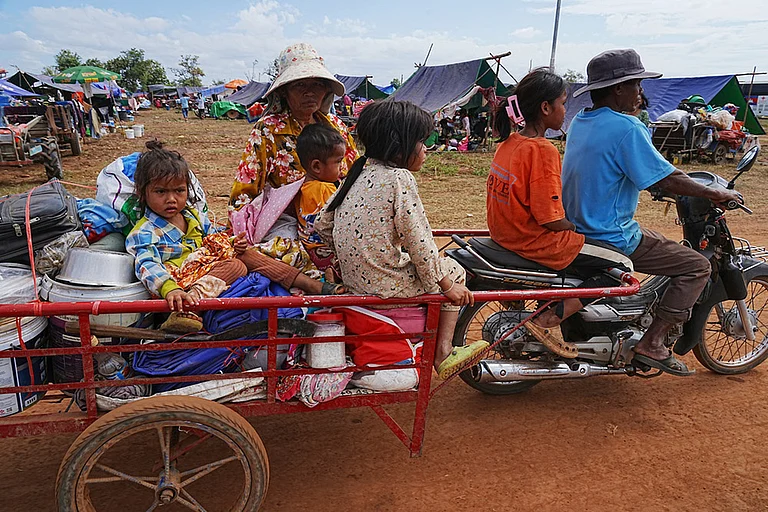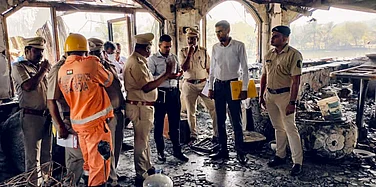Sulochana, a 52-year-old resident of Puthenvelikkara Panchayat, a low-lying village in the coastal belt of Ernakulam district, fears that her village could vanish in the next 10-20 years. She moved to Puthenvelikkara 36 years ago after getting married. Seasonal tides were once a normal part of life and not frightening. But now the water levels are gradually rising, often flooding her house. The pattern of the seasons has changed, and the tides, once temporary, have become the new normal.
People now experience tidal waves as an ever-present, intimidating force throughout the year. Unlike incidents of cyclones, flash floods and coastal erosion that attract media attention and force politicians and bureaucrats to visit the affected areas, tidal flooding is silent, slow, and immeasurable, but highly corrosive and far-reaching. The rising sea levels trigger an increase in backwater levels, pushing water into smaller waterbodies and inland streams. Saline water flows into roads, fields, plantations and houses, gradually eroding crops, making cooking and sleeping inside the house impossible and forcing people to either abandon their homes or rent houses where the water level is lower.
According to the studies done by EQUINOCT, an Ernakulam-based non-profit working on community-sourced solutions, the tidal floods are a direct and tangible impact of climate change all across the world. In Kerala, this phenomenon has intensified since the 2018 floods that caused the breaching of earlier thresholds of the rising of water levels. Though nine coastal districts have been affected by tidal flooding, they are yet to be declared as a natural disaster by the Kerala State Disaster Management Authority. A community-driven flood-resilient programme has been implemented in three panchayats in the worst-affected coastal belt of Ernakulam district, surrounded by backwaters. “It has been envisaged as community-driven programme with three key components―community mapping, training video volunteers and community theatre. “Bringing out the micro level data is key to finding a solution, which is being done by community mapping,” says Manjula Bharati, School of Habitat Studies, Tata Institute of Social Sciences (TISS), which headed the implementation of the programme.
“Over the past 10 years, the sea level has been rising by 4.9 mm annually. Ninety per cent of the heat produced by global warming is absorbed by the sea. Any liquid expands when heated, which is simple science. The sea thus expands onto the land and adjacent water streams, causing a permanent flood-like situation in low-lying areas,” says K G Sreeja, director (research), EQUINOCT. Tidal flooding occurs when the sea level rises above a certain threshold and enters inland through river mouths and tiny streams. Although this was a temporary phenomenon in the past, the frequency, intensity, and spread have drastically increased in recent times.
The coastal villages of Kerala, with a 590-km stretch of shoreline, are the worst-hit by tidal floods in recent years. Regular and increased inundation with saline water for most parts of the year in these areas causes lasting damage to homes, agriculture, and other infrastructure. In panchayats like Kumbalangi and Puthenvelikkara, people have abandoned their homes because of the irreparable damage caused by the permanent inundation of saline water. This migration, driven by climate change, remains unrecorded, and there is hardly any data on the people who have left their hard-earned belongings and moved out.
For those who have stayed behind, everyday life is a constant struggle. Routine household chores like cooking, feeding children, and nursing the elderly have become enormous tasks. “During flooding, we had to put chairs on the bed and sit on them throughout the night. Bricks had to be stacked in the kitchen to elevate a platform for the stove. In case of a medical emergency, it’s very hard to take someone to the hospital,” says Joseph and his wife Sheela, residents of Kumbalangi Panchayat. Not only are houses becoming unliveable, but traditional livelihoods like fishing, livestock rearing, and paddy farming are vanishing. “The saline water makes the land barren; it doesn’t even produce the green grass required for cows,” says Latha Dileep, a resident of Puthenvelikkara Panchayat and a daily-wage labourer under the Mahatma Gandhi National Rural Employment Guarantee Act (MGNREGA) who is part of the community-driven flood resilience programme.
Scholars working on community-driven solutions in the coastal villages of Ernakulam argue that the people living with tidal flood should be considered as climate refugees. “The impacts of aggravated tidal flooding on nature-based livelihoods cultivated over generations are another harrowing impact of climate change. Agricultural practices that were aligned with the seasons of tidal flooding have been compromised. Highly endemic fish populations and specialised fishing techniques in the backwaters are slowly dying,” says a report by EQUINOCT.




























